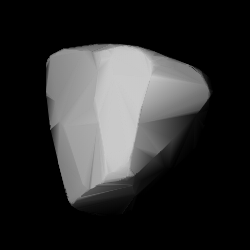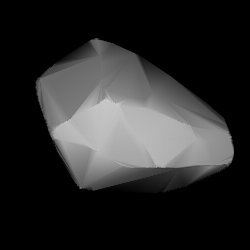1096 Reunerta, provisional designation 1928 OB, is an asteroid from the background population of the asteroid belt's central region, approximately 40 kilometers in diameter. It was discovered on 21 July 1928, by astronomer Harry Edwin Wood at the Union Observatory in Johannesburg, South Africa. The asteroid was named after South African engineer Theodore Reunert, supporter of the observatory and friend of the discoverer.

1135 Colchis ; prov. designation: 1929 TA) is a background asteroid from the central region of the asteroid belt. It was discovered on 3 October 1929, by Soviet astronomer Grigory Neujmin at the Simeiz Observatory on the Crimean peninsula. The X-type asteroid has a rotation period of hours 23.5 and measures approximately 49 kilometers in diameter. It was named for the ancient Kingdom of Colchis.
1120 Cannonia, provisional designation 1928 RV, is a stony Florian asteroid from the inner regions of the asteroid belt, approximately 10 kilometers in diameter. Discovered by Pelageya Shajn at Simeiz in 1928, it was named after American astronomer Annie Jump Cannon.
1123 Shapleya, provisional designation 1928 ST, is a stony Florian asteroid from the inner regions of the asteroid belt, approximately 11 kilometers in diameter. It was discovered on 21 September 1928, by Russian astronomer Grigory Neujmin at Simeiz Observatory on the Crimean peninsula. It was named after American astronomer Harlow Shapley.

1129 Neujmina is an Eos asteroid from the outer regions of the asteroid belt. It was discovered on 8 August 1929, by astronomer Praskoviya Parchomenko at the Simeiz Observatory on the Crimean peninsula. The stony S-type asteroid has a rotation period of 5.1 hours and measures approximately 34 kilometers in diameter. It was named after Soviet astronomer Grigory Neujmin.

1132 Hollandia, provisional designation 1929 RB1, is a stony asteroid from the middle region of the asteroid belt, approximately 27 kilometers in diameter. It was discovered on 13 September 1929, by Dutch astronomer Hendrik van Gent at Leiden Southern Station, annex to the Johannesburg Observatory in South Africa. It was named for the region Holland in the Netherlands.

1137 Raïssa is a stony background asteroid and slow rotator, approximately 22 kilometers in diameter, located in the inner regions of the asteroid belt. It was discovered by Grigory Neujmin at Simeiz Observatory in 1929, and named in memory of Raïssa Maseeva, who worked at the Pulkovo Observatory.
1151 Ithaka, provisional designation 1929 RK, is a carbonaceous asteroid from the inner regions of the asteroid belt, approximately 14 kilometers in diameter. It was discovered by Karl Reinmuth at the Heidelberg-Königstuhl State Observatory in 1929, and later named for the Greek island of Ithaca.
2126 Gerasimovich, provisional designation 1970 QZ, is a stony background asteroid from the inner regions of the asteroid belt, approximately 8 kilometers in diameter. It was discovered on 30 August 1970, by Soviet astronomer Tamara Smirnova at the Crimean Astrophysical Observatory in Nauchnyj, on the Crimean peninsula. The asteroid was named after Russian astronomer Boris Gerasimovich.
1271 Isergina, provisional designation 1931 TN, is a carbonaceous background asteroid from the outer regions of the asteroid belt, approximately 45 kilometers in diameter. It was discovered on 10 October 1931, by Soviet astronomer Grigory Neujmin at the Simeiz Observatory on the Crimean peninsula. The asteroid was named after Crimean physician and friend of the discoverer, Pyotr Isergin.
1176 Lucidor, provisional designation 1930 VE, is a carbonaceous background asteroid from the central region of the asteroid belt, approximately 30 kilometers in diameter. It was discovered by Eugène Delporte in 1930, who named it after a friend.
1303 Luthera, provisional designation 1928 FP, is a dark asteroid and the parent body of the Luthera family, located in the outermost regions of the asteroid belt. It measures approximately 90 kilometers in diameter. The asteroid was discovered on 16 March 1928, by astronomer Friedrich Schwassmann at the Bergedorf Observatory in Hamburg, Germany, and later named after German astronomer Robert Luther.

1484 Postrema, provisional designation 1938 HC, is a carbonaceous Postremian asteroid and namesake of the Postrema family from the central regions of the asteroid belt, approximately 41 kilometers in diameter. It was discovered on 29 April 1938, by Soviet astronomer Grigory Neujmin at the Simeiz Observatory on the Crimean peninsula. The name "Postrema" celebrates the astronomer's last minor planet discovery.
1306 Scythia, provisional designation 1930 OB, is a dark Ursula asteroid from the outer regions of the asteroid belt, approximately 72 kilometers in diameter. It was discovered on 22 July 1930, by Soviet astronomer Grigory Neujmin at the Simeiz Observatory on the Crimean peninsula. The asteroid was named for the historic region of Scythia.
1692 Subbotina, provisional designation 1936 QD, is a dark background asteroid from the central region of the asteroid belt, approximately 37 kilometers in diameter. The carbonaceous Cg-type asteroid has a rotation period of 9.2 hours. It was discovered by Grigory Neujmin at the Crimean Simeiz Observatory in 1936, and later named after Soviet mathematician and astronomer Mikhail Subbotin.

1424 Sundmania is a large asteroid and rather slow rotator from the background population of the outer regions of the asteroid belt. It was discovered on 9 January 1937, by astronomer Yrjö Väisälä at the Turku Observatory in southwest Finland. The dark X-type asteroid has a notably long rotation period of 93.7 hours and measures approximately 70 kilometers in diameter. It was named after Finnish astronomer and mathematician Karl F. Sundman.
1266 Tone is a dark background asteroid from the outer regions of the asteroid belt, approximately 80 kilometers in diameter. Discovered by astronomer Okuro Oikawa at the Tokyo Observatory in 1927, it was assigned the provisional designation 1927 BD. The asteroid was later named after the Tone River, one of Japan's largest rivers.
1511 Daléra, provisional designation 1939 FB, is an asteroid from the inner regions of the asteroid belt, approximately 12 kilometers in diameter. It was discovered on 22 March 1939, by French astronomer Louis Boyer at the Algerian Algiers Observatory, North Africa, and named after Paul Daléra, a friend of the discoverer.
1708 Pólit, provisional designation 1929 XA, is a very dark asteroid from the outer region of the asteroid belt, approximately 29 kilometers in diameter. It was discovered on 30 November 1929, by Spanish astronomer of Catalan origin Josep Comas i Solà at the Fabra Observatory in Barcelona, and was later named after Catalan astronomer Isidre Pòlit i Boixareu.
1544 Vinterhansenia, provisional designation 1941 UK, is a dark asteroid from the inner regions of the asteroid belt, approximately 22 kilometers in diameter. It was discovered on 15 October 1941, by Finnish astronomer Liisi Oterma at Turku Observatory in Southwest Finland, and named for Danish astronomer Julie Vinter Hansen.






